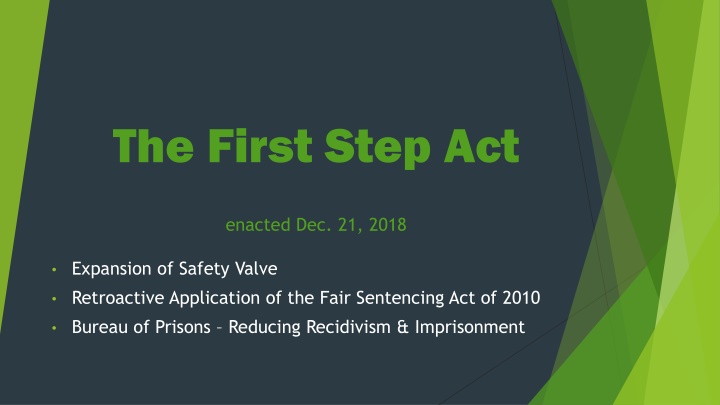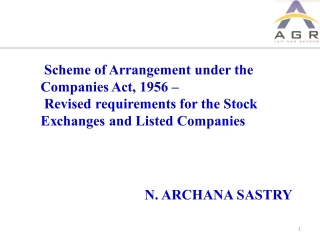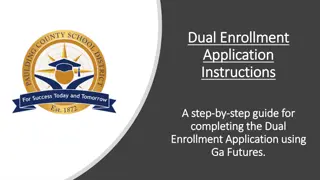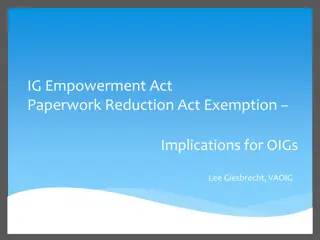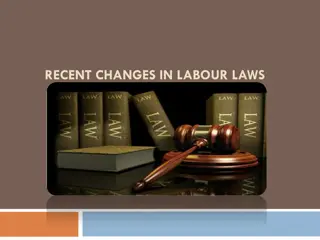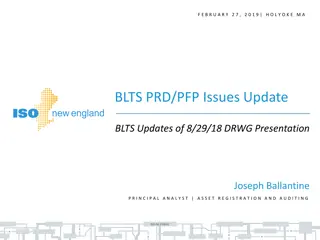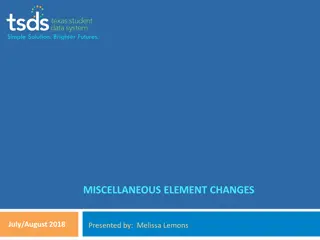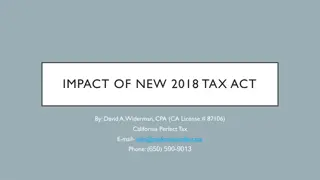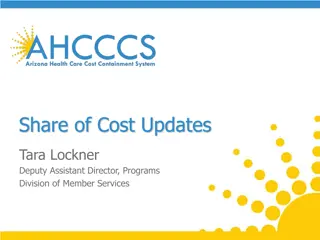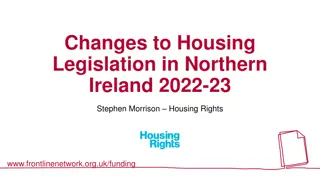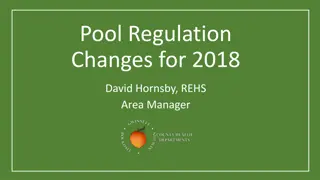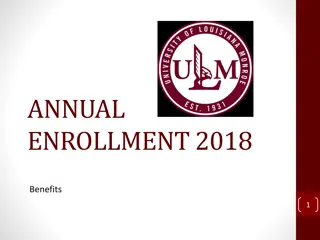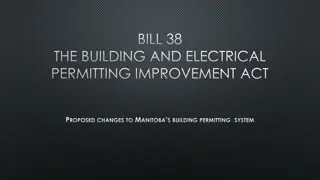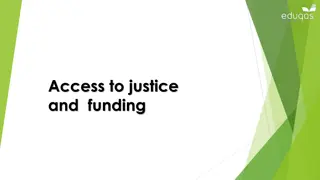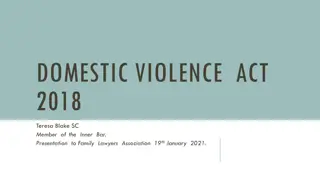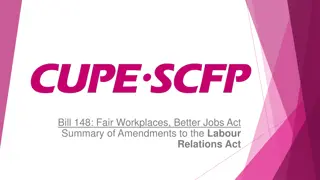Changes Introduced by the First Step Act of 2018
The First Step Act, enacted in December 2018, brought significant changes such as the expansion of safety valve, retroactive application of the Fair Sentencing Act of 2010, and initiatives to reduce recidivism and imprisonment. Sections like 402, 403, and 404 address safety valve broadening, clarifications in sentencing, and retroactive fairness. Notably, new provisions in Section 402 cater to specific offenses under title 46 USC 70503 and 70506, with criteria for eligibility explained. The Act also introduces earned time credits for compassionate and elderly releases. The impact of status points under section 3553(f)(1)(A) is examined in relation to criminal history points, providing insights into eligibility criteria for certain offenders.
Download Presentation

Please find below an Image/Link to download the presentation.
The content on the website is provided AS IS for your information and personal use only. It may not be sold, licensed, or shared on other websites without obtaining consent from the author.If you encounter any issues during the download, it is possible that the publisher has removed the file from their server.
You are allowed to download the files provided on this website for personal or commercial use, subject to the condition that they are used lawfully. All files are the property of their respective owners.
The content on the website is provided AS IS for your information and personal use only. It may not be sold, licensed, or shared on other websites without obtaining consent from the author.
E N D
Presentation Transcript
The First Step Act enacted Dec. 21, 2018 Expansion of Safety Valve Retroactive Application of the Fair Sentencing Act of 2010 Bureau of Prisons Reducing Recidivism & Imprisonment
On the Agenda Section 402 Broadens Safety Valve in Drug Cases Section 403 Clarifies that 924(c)(1)(C) applies only if final prior conviction (as always intended) Section 404 - Makes Fair Sentencing Act Retroactive Increases Good Time Credit to 54 days per year of sentence imposed (as always intended) New Earned Time Credits for some Compassionate & Elderly Release defendant/counsel can file the motion
Section 402 Safety Valve New: applies to offenses under title 46 USC 70503, 70506 (high seas cases) New (f)(1): Defendant does not have (A) more than 4 criminal history points, excluding any criminal history points resulting from a 1-point offense, as determined under the sentencing guidelines; (B) a prior 3-point offense, as determined under the sentencing guidelines; and (C) a prior 2-point violent offense , as determined under the sentencing guidelines. violent offense means a crime of violence, as defined in section 16 that is punishable by imprisonment, i.e., 16(a) force clause only has as an element the use, attempted use, or threatened use of physical force against another, punishable by imprisonment.
Section 402 Fun with plain language Placing the negative does not have before the subdivisions and connecting the subdivisions with and means D is disqualified only if has more than 4 points + 3-point offense + 2-point violent offense. Defendant does not have (A) more than 4 criminal history points, excluding any criminal history points resulting from a 1-point offense, as determined under the sentencing guidelines; (B) a prior 3-point offense, as determined under the sentencing guidelines; and (C) a prior 2-point violent offense, as determined under the sentencing guidelines. Briefing available contact FDO
Do Status Points Count toward total under 3553(f)(1)(A)? Per USSC newsletter: D. with two prior 2-point convictions (for non- violent offenses) and two criminal history points for status under 4A1.1(d) not eligible because has more than four criminal history points (excluding criminal history points for a 1-point offense) as determined under the sentencing guidelines Congress used the terms 1-point offense, 2-point offense, and 3-point offense, as a measure of seriousness, no mention of status points. The statute not a guideline controls, up to the judge, not USSC (by newsletter)
Applies to Career Offenders Career offenders can have 4 points or less, no 3-point offense, no 2-point violent offense Some career offender crimes of violence will not be safety valve violent offenses Safety valve violent offense : an offense that has as an element the use, attempted use, or threatened use of physical force against the person or property of another . . .that is punishable by imprisonment Must necessarily have element of force against person or property of another (Categorical Approach) No enumerated offenses 4B1.2(a): The term "crime of violence" means any offense under federal or state law, punishable by imprisonment for a term exceeding one year, that (1) has as an element the use, attempted use, or threatened use of physical force against the person of another, or (2) is murder, voluntary manslaughter, kidnapping, aggravated assault, a forcible sex offense, robbery, arson, extortion, or the use or unlawful possession of a firearm described in 26 U.S.C. 5845(a) or explosive material as defined in 18 U.S.C. 841(c). + aiding and abetting, conspiring, and attempting to commit such offenses (Commentary)
Section 402 Safety Valve Also New: Information disclosed by a defendant under this subsection may not be used to enhance the sentence of the defendant unless the information relates to a violent offense (as defined in 3553(f)) Applicability to Pending Cases shall apply only to a conviction entered on or after the date of enactment of this Act = whenever judgment is entered after sentencing on or after Dec. 21, 2018 Law: A conviction is entered when the judgment of conviction and sentence are entered on the district court docket. See Fed. R. Crim. P. 32(k)(1); Fed. R. App. P. 4(b)(6). Have briefing if needed. NDNY: As a matter of Department policy, prosecutors should take the position that the expanded safety valve applies to defendants who were found guilty pre-Act, but against whom judgment was or will be entered on or after December 21, 2018.
REMEMBER: Two additional levels off Guideline Range 2D1.1(b)(18) advises 2-level decrease if defendant meets old safety valve criteria at 5C1.2 Variance request under 3553(a)
Section 403 Clarification of Section 924(c) Amends 924(c)(1)(C): In the case of a second or subsequent conviction under this subsection violation of this subsection that occurs after a prior conviction under this subsection has become final, the person shall-- (i) be sentenced to a term of imprisonment of not less than 25 years; and (ii) if the firearm involved is a machinegun or a destructive device, or is equipped with a firearm silencer or firearm muffler, be sentenced to imprisonment for life. *Stacking remains 924(c)(1)(D) 15 yrs. instead of 55 yrs. for 3 convictions charged in same indictment Notwithstanding any other provision of law (i) a court shall not place on probation any person convicted of a violation of this subsection; and (ii) no term of imprisonment imposed on a person under this subsection shall run concurrently with any other term of imprisonment imposed on the person, including any term of imprisonment imposed for the crime of violence or drug trafficking crime during which the firearm was used, carried, or possessed.
Effective Date for Sections 401, 403? Applicability to Pending Cases. This section, and the amendments made by this section, shall apply to any offense that was committed before the date of enactment of this Act, if a sentence for the offense has not yet been imposed as of Dec. 21, 2018. Sec. 401(c), 403(b). Retroactive to past conduct in pending cases but only if sentence not yet imposed as of 12/21/18 At any resentencing after direct appeal or on collateral review if reversed/vacated on independent ground Counsel was IAC in failing to seek a continuance on or after widely publicized would not apply to people already in jail key dates: Aug. 3, Nov. 12, Nov. 16, 2018 ask for chart of relevant events If no resentencing or IAC: Failure to make applicable to sentences imposed before enactment violates Equal Protection Clause (no rational basis) and/or 8thAmend. (grossly disproportionate) As standalone ground on collateral review NO pending As standalone ground on direct appeal possible but problems
Section 404, Retroactive Application of Fair Sentencing Act of 2010 Section 2 of the FSA of 2010 modified the statutory penalties (i.e., statutory ranges and minimum SR terms) by increasing the quantities triggering: 841(b)(1)(A)(iii) and 960(b)(1)(C) from at least 50 grams to at least 280 grams 841(b)(1)(B)(iii) and 960(b)(2)(C) from at least 5 grams to at least 28 grams 841(b)(1)(C) and 960(b)(3) from less than 5 grams to less than 28 grams Section 3 eliminated the mandatory minimum for simple possession under 21 USC 844(a)
Section 404 of the First Step Act Applies to any covered offense -- a violation of a Federal criminal statute, the statutory penalties for which were modified by section 2 or 3 of the Fair Sentencing Act of 2010 [] that was committed before August 3, 2010. Sec. 404(a). freestanding remedy; 3582(c)(2)/1B1.10 do not apply) A court that imposed a sentence for a covered offense may, on motion, impose a reduced sentence as if sections 2 and 3 of the Fair Sentencing Act of 2010 [] were in effect at the time the covered offense was committed. Sec. 404(b). (limited only by MM under FSA if any, based on quantity element (not PSR); can reduce CO GLR based on lower stat max, find not CO under current guideline or law, vary from GLR) Only two circumstances in which court shall [not] entertain a 404 motion: sentence was previously imposed or previously reduced in accordance with the amendments made by sections 2 and 3 of the Fair Sentencing Act of 2010 (does not mean a previous guideline reduction under 3582(c)(2)/1B1.10) a previous motion made under this section to reduce the sentence was, after the date of enactment of this Act, denied after a complete review of the motion on the merits. Sec. 404(c). (one chance if 404 motion denied after complete review on the merits, not legal error in interpreting the law) But court has discretion: Nothing in this section shall be construed to require a court to reduce any sentence pursuant to this section. Sec. 404(c).
Do you have a client who may qualify? Contact Molly Corbett molly_corbett@fd.org Albany office. FPD will represent unless conflict or you want to represent. FPD has up-to-date litigation guidance. Do not proceed without it. Advise clients not to file pro se. If you see a pro se motion filed by a client (or co- defendant), advise FPD point person ASAP.
Good Time Credits? Earned Time Credits? Evidence-Based Programming?
Good Time Credit 54 days = 54 days per year of sentence imposed Drafting error: same effective date as for new risk and needs system the date AG completes and releases the risk and needs assessment system, i.e., 210 days after enactment June (July) 2019 DOJ: but that deadline may be subject to delay due to the lapse in appropriations that began on December 21, 2018 lasted about a month Congressional fix doubtful any time soon Want to litigate it? Contact Steve_Sady@fd.org
Practice Tips: when it happens Earned Time Credits Prerelease Custody for Some Some inmates would receive 10 days earned time credits per month of participation in programming; 5 days extra if classified low or minimum risk Transfer to prerelease custody (RRC, home confinement, supervised release) if credits equal to remainder of term of imprisonment + minimum or low risk according to last 2 risk assessments, or warden grants petition to waive Can't transfer to SR unless minimum or low according to last reassessment, and not to until less than 12 months left.
Practice Tips 68 categories not eligible to receive earned time credits (even though they earn them by participating in programming) based on instant offense Review list at 18 USC 3632(d)(4)(D) before entering into a plea bargain or considering sentencing strategy. Client may be able to plead to something else. Fight role enhancements where drug offenses excluded only if there is a role enhancement. Prevent judicial finding that even though the conviction is for trafficking in some other drug, it involved a detectable amount of fentanyl. Warn excluded clients they will not receive time credits unless the law changes to include them.
Partial List of Exclusions Drug offenses any drug offense resulting in death or serious bodily injury any offense under 841(b)(1)(A)(i) or (B)(i) heroin if the court finds at sentencing D was an organizer, leader, manager or supervisor any offense under 841(b)(1)(A)(viii) or (B)(viii) meth if the court finds at sentencing D was an organizer, leader, manager or supervisor all offenses under 841(b)(1)(A)(vi) or (B)(vi) fentanyl anyone sentenced under 841(b)(1)(A) or (B) for any drug if the sentencing court finds that the offense involved a mixture or substance containing a detectable amount of [fentanyl, and that the defendant was an organizer, leader, manager or supervisor. Argue: fentanyl finding would undermine rehabilitation by removing incentive for participating in recidivism reduction programming Not relevant to sentence the court is imposing
Partial List of Exclusions Immigration 8 USC 1326(b)(1) or (2), 8 USC 1327, 8 USC 1328 A prisoner is ineligible to apply time credits if the prisoner is the subject of a final order of removal under any provision of the immigration laws. AG and Secty of Homeland Security shall ensure that any alien described in 8 U.S.C. 1182 or 1227 who seeks to earn time credits are subject to proceedings described in 8 U.S.C. 1228(a) at a date as early as practicable during the prisoner s incarceration. Some others fraud and related activity in connection with computers, 18 USC 1030(a) All 924(c) but not ACCA All Kidnapping offenses in chapter 55; Bank robbery resulting in death, 18 USC 2113(e); Robberies and burglaries involving controlled substances, 18 USC 2118(c); all Carjacking under 2119(1), (2) or (3) Loads of sex and child porn crimes, including failure to register An offense described in 3559(c)(2)(F) if D was sentenced to a term of imprisonment of more than 1 year, and if has a previous federal or state conviction for a list of offenses and for which was sentenced to a term of imprisonment of more than 1 year Those subject to the criminal street gangs provision at 18 USC 521
Sec. 603(b), Increasing the Use & Transparency of Compassionate Release codified at 18 USC 3582(c)(1)(A) & (d)
Compassionate Release - 18 USC 3582(c)(1)(A) The court, upon motion of the Director of the Bureau of Prisons, or upon motion of the defendant after the defendant has fully exhausted all administrative rights to appeal a failure of the Bureau of Prisons to bring a motion on the defendant s behalf or the lapse of 30 days from the receipt of such a request by the warden of the defendant s facility, whichever is earlier, may reduce the term of imprisonment (and may impose a term of probation or supervised release with or without conditions that does not exceed the unserved portion of the original term of imprisonment), after considering the factors set forth in section 3553(a) to the extent that they are applicable, if it finds that (i) extraordinary and compelling reasons warrant such a reduction; or (ii) the defendant is at least 70 years of age, has served at least 30 years in prison, pursuant to a sentence imposed under section 3559(c), for the offense or offenses for which the defendant is currently imprisoned, and a determination has been made by the Director of the Bureau of Prisons that the defendant is not a danger to the safety of any other person or the community, as provided under section 3142(g); and that such a reduction is consistent with applicable policy statements issued by the Sentencing Commission.
USSC Policy Statement 1B1.13: Extraordinary and Compelling reasons vs. BOP Program Statement 28 USC 994(t) directs USSC to "describe what should be considered extraordinary and compelling reasons, not shall or may The court determines D not a danger to the safety of any other person or to the community, as provided in 18 U.S.C. 3142(g) + any of the circumstances set forth below Terminal illness: serious and advanced illness with an end of life trajectory, does not require specific prognosis of probability of death within a specific time period [diminished self-care not required] Non-Terminal Medical: serious physical or medical condition, serious functional or cognitive impairment, or deteriorating physical or mental health because of the aging process + substantially diminishes ability to provide self-care in prison and from which not expected to recover Age: at least 65 + deteriorating physical or mental health due to aging process + has served the lesser of 10 years or 75 percent of term of imprisonment [separate from 70-year-old who has served 30 years of a 3559(c) sentence elderly release] Family circumstances: death or incapacitation of minor child s caregiver, or D would be the only available caregiver for incapacitated spouse or registered partner Other: Any reason deemed extraordinary and compelling by BOP other than or in combination with above. BOP has added: (1) inmate sentenced after 11/1/87, 70 or older, has served 30 years or more; (2) at least 65 + deteriorating physical or mental health due to aging process + has served 50 percent of term of imprisonment, and (3) at least 65 + served greater of 10 years or 75 percent. BOP Prog. Stmt. 5050.50, 4.
First Step Act improvements The defendant can file the motion after fully exhausting administrative remedies or 30 days from receipt of request by warden, whichever is earlier. Defines terminally ill as a disease or condition with an end-of-life trajectory. 18 U.S.C. 3582(d)(1). Broader than USSC s serious and advanced illness with an end of life trajectory ? BOP shall, not later than 72 hours after the diagnosis of terminal illness notify the defendant s attorney, partner, and family members that they may prepare and submit on the defendant s behalf a request for a sentence reduction pursuant to [18 USC 3582(c)(1)(A)] BOP shall provide family and extended family opportunity for visitation within 7 days of diagnosis.
First Step Act improvements BOP shall upon request of D, his attorney, partner or family, ensure BOP employees assist D in preparing and submitting request to BOP. BOP shall process the request not later than 14 days of receipt of request. If D physically or mentally unable to submit a request to BOP, BOP shall Inform D s attorney, partner, and family that they may prepare and submit request to BOP, accept and process that request, or Upon request of D, his attorney, partner or family ensure BOP employees assist D in preparing and submitting request to BOP Visibly post new procedures at all BOP facilities.
Practical considerations Requires cooperation between: Lawyer in district of confinement for client contact, establish record of relevant facts, line up experts to establish not a danger/limitations (BOP will lie), exhaust admin remedies (or just submit and wait 30 days) Lawyer in district of conviction to file and litigate motion Some limits in BOP program statement not in USSC policy statement, but Congress authorized only USSC
Do you have a client who may be eligible? Contact FPD office If this does not result in needed representation, contact FAMM Or do it yourself: https://or.fd.org/system/files/case_docs/Compassion ate%20Release%20Basics_REVISED_2templates.pdf but coordinate with FPD office need someone in district of confinement this memo may be undergoing revision
